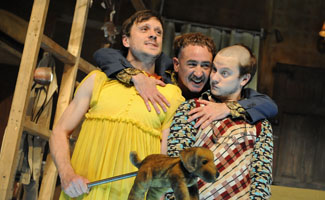 There are a few elements in Irish dramatist Enda Welsh’s play The Walworth Farce — currently on tour in the US in a Druid Theatre production directed by Mikel Murfi — that might confuse or perplex American audiences. The reference to fish fingers (commonly known as fish sticks here) is one that leaps out.
There are a few elements in Irish dramatist Enda Welsh’s play The Walworth Farce — currently on tour in the US in a Druid Theatre production directed by Mikel Murfi — that might confuse or perplex American audiences. The reference to fish fingers (commonly known as fish sticks here) is one that leaps out.
After last night’s performance at Zellerbach Playhouse in Berkeley was over, however, I ran into a British stage director friend who’s been working on this side of the pond for the last three decades and we engaged in a short but lively discussion about the play and, more broadly, the subject of farce in America.
The director thinks that comedies like The Walworth Farce don’t work out here because people don’t understand farce like Europeans do. He says there’s a tradition of slapstick in the U.S., but not farce, which is why, he claims, productions of plays by the likes of Martin McDonagh aren’t as great in the US as they are in the Europe.
To illustrate his point, he mentioned’s recent production of McDonagh’s The Lieutenant of Inishmore, which he said was inferior to the London production which he experienced. The reason the London production was better, he said, was because the actors bought into the crazy circumstances of the play lock, stock and barrel and took the audiences along with them. They were completely immersed in the absurdity of the scenario. Whereas, in the States, he said, audiences and production teams can’t quite go there. As a result, the actors on stage in Berkeley Rep’s Inishmore were too “knowing” — they were constantly indicating that they knew how how absurd the world of the play was through facial and body gestures as well as through the way they said some of their lines, therefore they created a bit of a comfortable distance between themselves and the play.
The difference between farce and slapstick is a subtle one. In one online dictionary, farce is defined as, “a light dramatic work in which highly improbable plot situations, exaggerated characters, and often slapstick elements are used for humorous effect.” Slapstick is defined as, “a boisterous form of comedy marked by chases, collisions, and crude practical jokes.”
I don’t have European productions of McDonagh plays with which to compare the ones I’ve seen in the US. By and large, I’ve found myself to be completely immersed in the farcical worlds of these American-produced experiences though. So I’m not sure I wholeheartedly agree with my director friend, though he raises a fascinating point.
I actually think this nation is great at farce. The Matt Damon movie, The Informant! is steeped in farce, as are stage works by some of our local playwrights like Peter Sinn Nachtrieb and Aaron Loeb. Anyone who’s seen productions of Nachtrieb’s Hunter Gatherers or Boom, or Loeb’s Abraham Lincoln’s Big Gay Dance Party will know what I mean. And wasn’t the Bush Administration pure farce?

 If a comet were to crash into the Earth, it would make quite a dent.
If a comet were to crash into the Earth, it would make quite a dent. Artists are becoming very savvy about marketing themselves these days. Everyone’s out there on FaceBook and MySpace and Twitter sending out news about their work and related upcoming events to generate interest and hopefully sell tickets.
Artists are becoming very savvy about marketing themselves these days. Everyone’s out there on FaceBook and MySpace and Twitter sending out news about their work and related upcoming events to generate interest and hopefully sell tickets.
 …is it possible to walk down the street swinging a yoga mat and be accosted by a homeless person pushing a Safeway cart in grimy clothes who says: “Pilates?” by way of introduction.
…is it possible to walk down the street swinging a yoga mat and be accosted by a homeless person pushing a Safeway cart in grimy clothes who says: “Pilates?” by way of introduction. San Francisco is probably the most sexually tolerant city in the world. There are few places where people can walk around in nothing but socks and sneakers with bells dangling from their privates without getting arrested and San Francisco is one of them. Ironically, the fact that the city is so gay-friendly makes the latest work by the luminescent British physical theatre company
San Francisco is probably the most sexually tolerant city in the world. There are few places where people can walk around in nothing but socks and sneakers with bells dangling from their privates without getting arrested and San Francisco is one of them. Ironically, the fact that the city is so gay-friendly makes the latest work by the luminescent British physical theatre company  Here’s a list of qualities that British theatre productions seem to think they need to possess in order to “succeed” in the U.S. market:
Here’s a list of qualities that British theatre productions seem to think they need to possess in order to “succeed” in the U.S. market: There’s something to be said for the fact that retreat centres try to get the people who visit them to unplug for the duration of their stay. That’s the whole point of going on a retreat — to get away from the hustle and bustle of everyday life. But following an experience I had during a recent visit to the
There’s something to be said for the fact that retreat centres try to get the people who visit them to unplug for the duration of their stay. That’s the whole point of going on a retreat — to get away from the hustle and bustle of everyday life. But following an experience I had during a recent visit to the 
 Arts organizations try many different tactics to get young people through their doors, from offering low-cost tickets and organizing party nights with DJs to doing in-schools programs and partnering with other organizations that are more closely tapped into youth culture like capoeira clubs and skateboarding stores.
Arts organizations try many different tactics to get young people through their doors, from offering low-cost tickets and organizing party nights with DJs to doing in-schools programs and partnering with other organizations that are more closely tapped into youth culture like capoeira clubs and skateboarding stores.

 Three Bay Area-based dramatists had the following to say in response to this question:
Three Bay Area-based dramatists had the following to say in response to this question: Finessing a sudden change in mood from comedy to tragedy and visa versa in the theatre is a challenging feat. I was reminded of this fact last night at a performance of Dominic Dromgoole’s
Finessing a sudden change in mood from comedy to tragedy and visa versa in the theatre is a challenging feat. I was reminded of this fact last night at a performance of Dominic Dromgoole’s